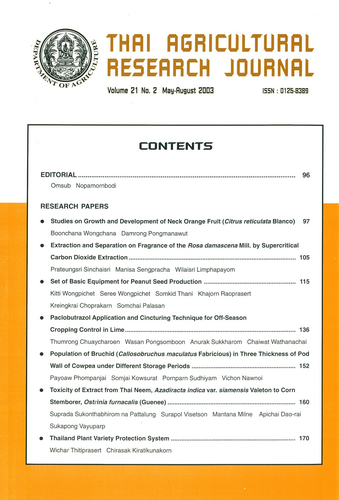Pcalobutrazol application and Cincturing Technique for Off-Season Cropping Control in Lime
DOI:
https://doi.org/10.14456/thaidoa-agres.2003.11Keywords:
off-season, cumulative flowering, trunk-base cincturing, paclobutrazol, soil drenchAbstract
A lack of crop yield in lime occurs every year, especially during the dry season due to naturally low flowering capacity. The effective procedure for an enhancement of off-season flowering in lime is being developed by using the modification of the paclobutrazol technology and tree cincturing technique in Thailand. Three to five-year-old trees of the ‘Panrumpai’ lime variety propagated by air layering were experimented on the private orchards at Phichit during 1999-2000 and Kamphaeng Phet during 2000-2001. The sandy loam soil condition is classified Pichit experimental site while Kamphaeng Phet is characterize to be the clay soil growing environment. It was evident that in the sandy loam soil condition, all the treatments except the non-treated control were capable for inducing early off-season flowering. There was statistically significant difference in the cumulative flowering percentage among the treatments. The greatest flowering at average 82.6% was present on the trees treated with the pcalobutrazol -soil application at the rate of 1.0 gram/meter-of canopy diameter combined with trunk base cinctured and tightened with rope. Consequently, the off-season yield was also maximum with the average number of 1,135.4 fruits/tree. In contrast, there were lowest off-season flowering at average 17.0% and subsequently, the smallest number of 313.2 fruits/tree observed on the non-treated tree. Similarly, under the clay soil environment, all the treatments except the non-treated control could induce early off-season flowering. Profuse flowering with the greatest percentages at 83.8% and 84.0% developed on the trees treated with the pcalobutrazol soil drench at the rate of 0.5 grams/meter-of canopy diameter combined with the trunk base cinctured and tightened with rope and wire respectively. Consequently, the maximum off-season yield was also harvested from those two treated-tree groups with the average numbers of 1,531.1 and 1,480.9 fruits/tree, respectively. In the mean time, the non-treated control trees developed the minimum flowering at average 16.3% and the subsequent smallest number of average 447.4 fruits/tree.
Downloads
Published
How to Cite
Issue
Section
License

This work is licensed under a Creative Commons Attribution-NonCommercial-NoDerivatives 4.0 International License.
Thai Agricultural Research Journal



